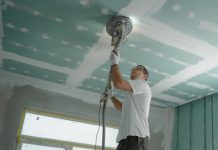The adoption of smart homes in the UK is proceeding so quickly that it outpaces saying “Alexa, turn on the lights.”
The numbers don’t lie. Analysts predict that by 2027 UK smart home adoption will reach 50.2%, covering 15.1 million households. Smart technology adoption will reach a point where 50% of UK homes function like the Jetsons!
But here’s what most homeowners don’t realize…
The electrical infrastructure of your home didn’t anticipate the needs of modern smart home technology. Installing smart devices without updating your electrical system compares to racing a Formula 1 car with a bicycle engine.
Here’s the problem:
Homes constructed before 2010 face challenges in meeting smart home technology requirements with their outdated electrical systems. These new technologies require proper wiring together with adequate power distribution and occasionally complete electrical overhauls to operate safely.
What you’ll discover:
- Why Smart Homes Need Electrical System Upgrades
- Essential Electrical Upgrades for Smart Home Integration
- Safety Considerations and Code Compliance
- Cost Analysis of Smart Home Electrical Upgrades
Why Smart Homes Need Electrical System Upgrades
Smart home technology operates in a completely new way when compared to traditional electrical devices. Modern smart devices demand constant connectivity to function correctly and require dedicated circuits with specific power requirements which can burden older electrical systems.
A typical smart home system consists of smart lighting solutions together with thermostats and security cameras along with smart locks, voice assistants and automated blinds. Both dependable power supply and network connectivity are essential for each device to function properly. The original home wiring only supported basic on/off switches which cannot handle modern smart devices.
Without proper electrical infrastructure, you risk:
- Frequent power outages from overloaded circuits
- Fire hazards from improper installations
- Device malfunctions and connectivity issues
- Voided insurance claims due to non-compliant wiring
Homeowners usually find these installation flaws too late when they become costly to correct.
Electrical Load Requirements for Smart Devices
The most widespread misunderstanding about smart home technology involves its minimal power consumption. Wrong!
The total power consumption of multiple devices can exceed the limits of outdated electrical wiring systems even though each device alone appears to use minimal energy. The continuous operation of smart thermostats along with security systems and automated lighting networks creates constant power demands which may exceed the safe handling capacity of your home’s electrical panel.
Essential Electrical Upgrades for Smart Home Integration
The hidden truths about smart home installations electricians typically do not disclose upfront include…
The installation of smart home technology requires substantial electrical modifications which extend beyond just connecting devices. If infrastructure changes for smart home integration lack proper planning they become both extensive and costly.
When considering smart home installations, hiring a local electrician becomes crucial for ensuring your electrical system can handle the increased demands. Hiring a professional helps avoid expensive errors and risky installations.
Circuit Capacity and Distribution Upgrades
The electrical circuits in smart homes face higher demands compared to traditional home setups. Basic lighting and outlets work with your current circuits but adding smart switches, security cameras and automated systems will exceed your system’s capacity.
Many older homes feature 15-amp circuits that are unable to handle multiple smart devices operating at the same time. You’ll likely need:
- Additional 20-amp circuits for high-demand smart appliances
- Dedicated circuits for security systems and networking equipment
- GFCI protection for smart devices in wet areas like bathrooms and kitchens
- Arc-fault circuit interrupters for fire safety compliance
The UK’s investment in a GBP 40 million 5G innovation fund means faster connectivity is coming. Your home electrical system requires an upgrade to support the networking equipment enabling this connectivity.
Smart Panel and Monitoring Systems
Conventional electrical panels do not support smart home management needs. Contemporary smart panels deliver live power monitoring while managing circuits individually and connect to home automation networks.
Smart electrical panels provide:
- Remote monitoring of power consumption by circuit
- Automatic load balancing to prevent overloads
- Integration with renewable energy systems
- Enhanced safety features and fault detection
- Smartphone apps for system management
Smart panels lower your electricity bills by detecting energy waste and managing power distribution efficiently across your home.
Wiring Infrastructure Modernization
For homeowners to effectively add new devices their primary obstacle becomes the necessary modernization of existing electrical wiring infrastructure. Homes built before modern building codes commonly contain aluminum wiring systems and lack appropriate grounding which results in safety risks.
Modern smart homes require:
- Cat6 ethernet cables for reliable networking
- Upgraded electrical cables rated for higher loads
- Proper grounding systems for electronic devices
- Surge protection at the panel level
- Low-voltage wiring for automation systems
Safety Considerations and Code Compliance
The Product Security and Telecommunications Infrastructure Act was established by the UK to set security standards for connected devices. The new legislation defines the necessary procedures for integrating smart home technologies into electrical infrastructure.
Smart device installations must comply with:
- BS 7671 wiring regulations for electrical safety
- Part P building regulations for electrical work
- Product-specific installation requirements
- Insurance compliance standards
DIY smart home electrical installations may breach these regulations and result in your home insurance becoming invalid. Professional installation protects your investment while guaranteeing regulatory compliance.
Cost Analysis of Smart Home Electrical Upgrades
When planning smart home expenses homeowners include device costs yet ignore the necessary electrical infrastructure. Installing a £200 smart thermostat could involve £800 of electrical work to ensure safe operation.
Typical electrical upgrade costs include:
- Circuit additions: £150-£300 per circuit
- Panel upgrades: £1,200-£2,500 for complete replacement
- Rewiring sections: £100-£150 per room
- Smart panel installation: £2,000-£4,000
- Professional inspection and certification: £200-£400
Intelligent electrical systems can achieve annual energy cost reductions between 10% and 15% by implementing smart load management and monitoring techniques. The accumulated savings eventually balance out the original expenses.
Future-Proofing Your Electrical Infrastructure
Homeowners prioritize today’s requirements when planning smart home electrical systems without considering future growth needs. The rapid growth of IoT device usage guarantees that your smart home infrastructure will expand over time. Planning ahead saves massive headaches later.
Consider these emerging electrical demands:
- Electric vehicle charging stations requiring 240V circuits
- Solar panel integration and battery storage systems
- Whole-home backup generators with automatic transfer switches
- High-power smart appliances and HVAC systems
- Advanced security systems with multiple cameras and sensors
Proactive electrical planning requires you to install additional circuits and upgrade panel capacity before you actually need them. It’s much cheaper than retrofitting later.
Selecting Professional Electrician Services
A number of electricians lack knowledge about electrical requirements for smart homes. It’s important to hire specialists who remain informed about both current technological advancements and safety standards.
When evaluating electrician services, look for:
- Part P certification for electrical work
- Experience with smart home installations
- Knowledge of current wiring regulations
- Insurance and proper licensing
- Familiarity with major smart home brands
Selecting the correct electrician ensures you have a reliable partner to build a smart home electrical system that maintains safety and efficiency while adapting to your evolving requirements.
Staying Ahead of Technology Changes
The smart home revolution is just beginning. The expansion of 5G networks and advancement of IoT devices means electrical demands will keep rising.
Future smart homes might include:
- Wireless power transmission systems
- AI-powered electrical management
- Integration with smart grid technology
- Advanced energy storage solutions
- Ultra-high-speed networking requirements
A proper electrical system upgrade now prepares your home to embrace upcoming technological innovations.
Time to Get Started
Smart home technology provides remarkable convenience and efficiency which requires proper electrical infrastructure support to function effectively.
Identify electrical problems before the installation process to ensure a smooth setup for your smart home technology. Begin with a professional assessment then plan for your home’s future needs and invest in quality electrical work to ensure safe smart home operations.
Today’s technology exists alongside a flourishing market which provides evident advantages. Make sure your system is ready.




